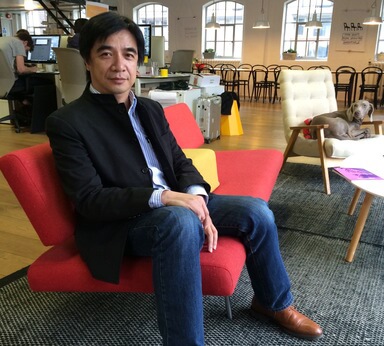A Visitor From Shenzhen

Last week here in the Made by Many offices, we received a special guest all the way from the Shenzhen region of China: Mr Victor Chen.
Victor and his company Gadget Lab are handling the manufacturing of the plastics, electronics and packaging for our connected device Hackaball, so we took the opportunity to quiz him on the nuts & bolts of bringing a connected product to life between East London and the Far East.

What does a typical day's work at Gadget look like for you, Victor?
Normally I spend half my time working on emails, answering customer’s questions. Gadget Lab is a small team and we don’t spend a lot of time on meetings. I spend quite a lot of time on visiting factories, vendors and design houses, around one to two days per week. To us it's important to build a tight communication with factories. Quite often I leave office a bit later, to be able to talk to customers in Europe online.
What are the biggest challenges involved in manufacturing a product such as Hackaball?
For the new inventor's projects, most of the time it will involve some new production procedure, new combinations of different materials, and new technology, and it will need to be delivered to market in a very short time. To us the biggest challenge is the reliability of the product. Getting a reliable product isn't just about the factory: it starts with the design, selection of materials, test procedure in the firmware – all of these need to be communicated properly between the different parties of the project, and in a very short time.
Can you tell us about manufacturing the necessary elements of Hackaball – packaging, electronics and plastics?
Material and environmental safety are the major elements in manufacturing Hackaball. For all of the packing material in Hackaball, we use the recyclable material. Also, the processes of manufacturing the electronics boards and plastic parts all meet with the latest CE requirements, making sure all of the materials are safe for kids and the environment. The factory we are using is ICTI certified , qualified to make toy products for all the major toy companies.
Increasingly we see more and more connected objects coming to market: how do you see the this area of design and manufacture developing?
One of the biggest challenges from the manufacturing side is more and more personal customised design products, and shorter and shorter product life cycles, which means manufacturers have to bring in more new products with a much shorter lead time. The general mass production quantity is much lower than before.
Kickstarter has been important to the success of Hackaball: how do you see crowdfunding changing the way products are designed and manufactured?
Kickstarter has helped to bring lots of new ideas and new products to market. It's a strong platform for inventors to communicate their idea with potential customers at an earlier stage. For manufacturers, working on a Kickstarter project is very different from a traditional contracted customer. Most of the time traditional contracted or trading customers already have a good idea of how they want their product be made when they start talking to manufacturers. But for Kickstarter projects, most of the inventors aren't familiar with the process between idea and the product. Manufacturers need to have good capability in communication to understand the product, and be more patient in explaining the manufacturing process to inventors. Also manufacturers need to have wider experience and knowledge to provide different solutions, to help inventors with solving all kinds of new problems that come with new designs.
Is the cycle of design to manufacture for connected objects getting faster? And what are some good ways to speed the process up?
Yes! The best way to deal with this is earlier involvement – bringing in the manufacturing engineer in the early stages of product design is very important. It's much better to talk with manufacturers before launching the Kickstarter campaign, rather than only starting to consider the manufacturing after the campaign's success.
What have the reactions been to Hackaball among your colleagues in China?
In the beginning it was a bit difficult for our colleagues in China to understand the concept of the product – the concepts of education and children's play are very different between western and Chinese culture – until we explained the concept by introducing the App. We all love the design of the ball, love the touch of the silicon rubber surface.
Hackaball is coming soon – find out about it here.
Continue reading
The Problem with Design Thinking
It may have a great name, but Design Thinking no longer packs a punch big enough to drive universe-denting, full-stack innovation. Here’s why we need ‘Ful...
Asking the question: should designers code?
If you asked me “Should designers code?”, I wouldn’t be able to answer you. The question serves as a popular op-ed headline, but drops context in favor fo...
Experiments in remote user testing
Customers are at the heart of everything we make at Made by Many. We try to ensure we’re always talking to them, showing them our work in progress, and ge...

